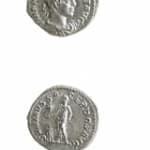Silver Denarius of Emperor Elagabalus, 220 CE - 222 CE
Silver
C.5416
Obverse: IMP ANTONINVS PIVS AVG; Laureate, Draped, and Horned Bust of the Emperor Facing Righ Reverse: SVMMVS SACERDOS AVG; Elagabalus Standing Offering from a Patera over an Altar to the...
Obverse: IMP ANTONINVS PIVS AVG; Laureate, Draped, and Horned Bust of the Emperor Facing Righ
Reverse: SVMMVS SACERDOS AVG; Elagabalus Standing Offering from a Patera over an Altar to the Left, Holding a Branch, Star in Field to Lef
Elagabalus became emperor through the diligence and bravery of his grandmother, Julia Maesa. A powerful and immensely wealthy woman of the Severan family, she incited the Syrian legions stationed at Emesa to revolt against Macrinus in favor of her grandson. Although his Roman name was Bassianus, Elagabalus derives from his position as high priest of Elagabal, the Syrian god Ba’al. Elagabalus was one of the more scandalous rulers in Roman history. He was famed for hosting wild parties where overindulgence of all types was encouraged. The Eastern gods he brought to Rome were strange even to the permissive Roman society of the day. Perhaps his most offensive act was marrying a Vestal Virgin. To the Romans this act of Elagabalus not only desecrated their religion, but also their heritage. Julia Maesa attempted to regain control of the situation by having her other grandson, Severus Alexander, declared Caesar. When Elagabalus revoked this promotion, the Praetorian Guard, encouraged by Julia Maesa, rebelled against their emperor, hunted down, and executed Elagabalus.
How many hands have touched a coin in your pocket or purse? What eras and lands have the coin traversed on its journey into our possession? As we reach into our pockets to pull out some change, we rarely hesitate to think of who might have touched the coin before us, or where the coin will venture to after it leaves our hands. More than money, coins are a symbol of the state that struck them, of a specific time and location, whether contemporary currencies or artifacts of a long forgotten empire. This stunning hand-struck coin reveals an expertise of craftsmanship and intricate sculptural detail that is often lacking in contemporary machine-made currencies. This ancient coin is a memorial an emperor’s brief reign passed from the hands of civilization to civilization, from generation to generation that still appears as vibrant today as the day it was struck.
Reverse: SVMMVS SACERDOS AVG; Elagabalus Standing Offering from a Patera over an Altar to the Left, Holding a Branch, Star in Field to Lef
Elagabalus became emperor through the diligence and bravery of his grandmother, Julia Maesa. A powerful and immensely wealthy woman of the Severan family, she incited the Syrian legions stationed at Emesa to revolt against Macrinus in favor of her grandson. Although his Roman name was Bassianus, Elagabalus derives from his position as high priest of Elagabal, the Syrian god Ba’al. Elagabalus was one of the more scandalous rulers in Roman history. He was famed for hosting wild parties where overindulgence of all types was encouraged. The Eastern gods he brought to Rome were strange even to the permissive Roman society of the day. Perhaps his most offensive act was marrying a Vestal Virgin. To the Romans this act of Elagabalus not only desecrated their religion, but also their heritage. Julia Maesa attempted to regain control of the situation by having her other grandson, Severus Alexander, declared Caesar. When Elagabalus revoked this promotion, the Praetorian Guard, encouraged by Julia Maesa, rebelled against their emperor, hunted down, and executed Elagabalus.
How many hands have touched a coin in your pocket or purse? What eras and lands have the coin traversed on its journey into our possession? As we reach into our pockets to pull out some change, we rarely hesitate to think of who might have touched the coin before us, or where the coin will venture to after it leaves our hands. More than money, coins are a symbol of the state that struck them, of a specific time and location, whether contemporary currencies or artifacts of a long forgotten empire. This stunning hand-struck coin reveals an expertise of craftsmanship and intricate sculptural detail that is often lacking in contemporary machine-made currencies. This ancient coin is a memorial an emperor’s brief reign passed from the hands of civilization to civilization, from generation to generation that still appears as vibrant today as the day it was struck.



